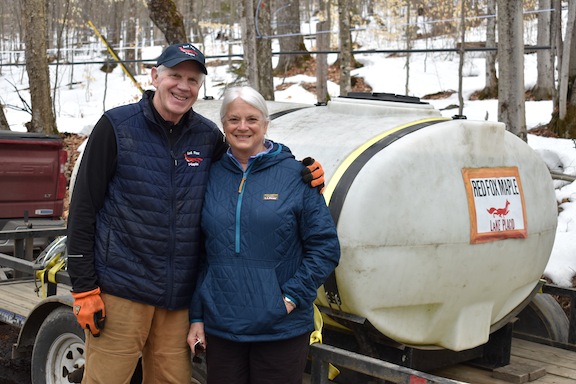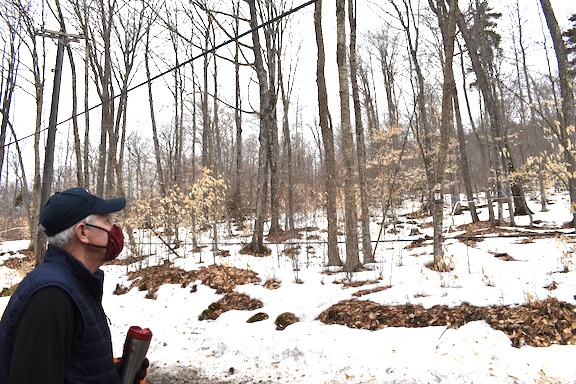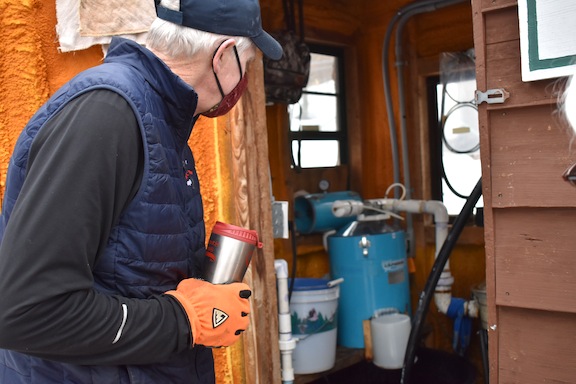Touring Red Fox Maple
A virtual Maple Weekend from Lake Placid
- Randy Quayle looks out over the Red Fox Maple sugarbush on Wednesday, March 24. (News photo — Elizabeth Izzo)
- Randy Quayle looks into a shed where a vacuum pump and maple sap releaser are stored. (News photo — Elizabeth Izzo)
- Randy and Sibyl Quayle are pictured here beside the tank Red Fox Maple’s sap is transferred to when it is transported to the Uihlein Maple Research Forest. (News photo — Elizabeth Izzo)

Randy and Sibyl Quayle are pictured here beside the tank Red Fox Maple’s sap is transferred to when it is transported to the Uihlein Maple Research Forest. (News photo — Elizabeth Izzo)
LAKE PLACID — Blink and you’ll miss it.
Nestled among a neighborhood of camps bordering Lake Placid lake on Blodgett Road is a property owned by Randy and Sibyl Quayle, a retired school psychologist and teacher, respectively. At first glance, the land looks like typical Adirondack wilderness — trees, fallen leaves and plenty of snow on a hillside. But look closer and details will emerge: light blue taps affixed to sugar maple trees, red marks on the trees where taps once were, and a network of tubes that carry sap into a small shed in the forest.
This is Red Fox Maple, a 1,000-tap sugarbush that the Quayles run as a hobby. It’s a lot of work, but the couple enjoys it.
“We just love being in the woods … and we love maple syrup,” Sibyl said, smiling.
The New York State Maple Producers Association canceled the New York State Maple Weekends — March 21-22 and March 28-29 — for a second year because of the coronavirus pandemic. So the Lake Placid News took a tour of Red Fox Maple to learn more about this local operation.

Randy Quayle looks out over the Red Fox Maple sugarbush on Wednesday, March 24. (News photo — Elizabeth Izzo)
Red Fox Maple is unique in a lot of ways, but perhaps the most significant one is that it’s something of a community effort each season. When the sap starts flowing around this time each year, the Quayles monitor their hillside sugarbush on a daily basis, whether in person or by using a program that sends live information to their mobile devices.
But they’ve got a lot of friends helping them out, too — many of them longtime Lake Placid residents, some of them friends from places like St. Louis and New York City. This year, the Quayles’ nephew Simon has helped out. Locally, Doug Roode, Tom Dodd, Dean Dietrich, Peter Lynch, Don Morris, Paul Gutmann and Robert Garrett have volunteered their time, as have a lot of others over the years.
The coronavirus pandemic has made it harder to operate the sugarbush because fewer people can help. The Quayles have to adhere to public health restrictions just like many other businesses, and in their case, they’ve been limited to basically running the sugarbush on their own this season.
The sugarbush is spread out across 16 acres of land that was purchased by Sibyl’s grandfather in the 1920s. The couple didn’t start collecting sap from the trees there until 2010.
Much of the equipment — the series of tubing and the vacuum-suction system that brings the sap from the maple trees into the storage shed — stays up year-round. But the tapholes change each year, Randy said, when the taps create what are essentially dead zones in trees, meaning sap won’t flow to that area of the tree for some time.

Randy Quayle looks into a shed where a vacuum pump and maple sap releaser are stored. (News photo — Elizabeth Izzo)
The sap collected from the maple trees gets transferred into a large storage tank, which is then transferred to a smaller storage tank attached to a truck. Randy drives the sap over to Cornell University’s Uihlein Maple Research Forest on Bear Cub Lane in Lake Placid, where Adam Wild, the director of the forest, makes it into maple syrup.
“We have a line that connects to his tank that he has on his trailer,” Wild said. “He connects his line to the tank and downloads his sap into our collection tank.”
The sap isn’t processed separately. Instead, it’s incorporated into Cornell’s sap collection, which is taken from about 6,000 maple trees on the property. The same happens for other producers that bring their sap to the Uihlein Maple Research Forest. There’s currently one other producer like Red Fox that brings sap on a regular basis, a Lake Placid resident named Junior Thompson, Wild said.
The sap is transferred to the sugarhouse, filtered and put into a reverse osmosis machine, removing most of the water from the sap, before it’s processed through an evaporator and boiled down into syrup. When the sap is drawn, it is stored in 40-gallon stainless steel drums before being packaged at a later date.
It takes about 30 to 40 gallons of sap to make one gallon of maple syrup. Wild calculates how much syrup the Quayles are owed, and Cornell keeps a portion of it as payment for processing the sap.
Wild said the Quayles usually package their own syrup, and they essentially split the revenue from their syrup with the Shipman Youth Center in Lake Placid, which sells it as a fundraiser.
The actual grade of the syrup varies. There are four grades: golden, amber, dark and very dark.
“The way we grade is based on light transmittance,” Wild said, referring to the light that filters through the syrup when it’s held up to the light.
Think of it like regular sugar. The more caramelized the sugar is, the darker it is. The more fructose — or fruit sugar — exists within sap, the heavier the caramelization, and the more robust the maple flavor. There are a lot of variables that can influence how much fructose there is in sap, but for the most part, it’s kind of a dice roll. Wild said the grading isn’t determined so much by the process of making the syrup but by the “profile of the trees.”
As for what to do with that syrup once it’s made? Syrup on pancakes is a classic, but as the owners of a sugarbush, the Quayles have found a lot of other uses over the years.
“We use it on yogurt, oatmeal. I use it in glazes for fish. I use it in salad dressings. You just pour it on vanilla ice cream,” Sibyl said. “Pretty much anything you use sugar in, you can use maple in.”



